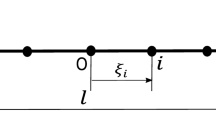Abstract
Statistical Energy Analysis (SEA) is generally used for the high frequency analysis in various areas. In the present paper a SEA-related study concerning coupled structures consisting of beams and plates is discussed. Firstly, the Fourier technique is explained to obtain the energies and power flows for excitation on the beam and the plate. Then, these are used in the Power Injection Method (PIM) to obtain the effective Coupling Loss Factors (CLFs) of the single beam-plate system. Overlapping octave bands are used in a frequency average approach. Based on the analysis for the beam-plate structure, the beam-plate-beam structure is also investigated in the SEA framework. It is found that the indirect coupling in an SEA sense may exist for such a beam-plate-beam coupled structure. The numerical result shows that its effect is larger when the dimensions of beams are similar.
Similar content being viewed by others
References
Bies, D. A. and Hamid, S., 1980, “In Situ Determination of Loss and Coupling Loss Factors by the Power Injection Method,”Journal of Sound and Vibration, Vol. 70, pp. 187–204.
Craik, R. J. M., 1996,Sound Transmission through Buildings using Statistical Energy Analysis, Gower Publishing, Aldershot
ESDU 99009, “An Introduction to Statistical Energy Analysis”.
Fahy, F. J. and Mohammed, A. D., 1992, “A Study of Uncertainty in Applications of SEA to Coupled Beam and Plate Systems, Part 1: Computational Experiment,”Journal of Sound and Vibration, Vol. 158, pp. 45–67.
Fahy, F. J., 1994, “Statistical Energy Analysis: a Critical Overview,”Philosophical Transactions of the Royal Society of London, series A, Vol. 346, pp. 431–447.
Grice, R. M. and Pinnington, R. J., 1999, “A Method for the Vibrational Analysis of Built-up Structures, Part 1: Introduction and analytical analysis of the plate-stiffened beam,”Journal of Sound and Vibration, Vol. 230, pp. 825–849.
Heron, K. H., 1997, “Advanced Statistical Energy Analysis,”Philosophical Transactions of the Royal Society of London, series A, Vol. 346, pp. 501–510.
Jayachandran, V. and Bonilha, M. W., 2003, “A Hybrid SEA/Modal Technique for Modelling Structural-acoustic Interior Noise in Rotorcraft,”Journal of Acoustical Society of America, Vol. 113, pp. 1448–1454.
Ji, L., Mace, B. R. and Pinnington, R. J., 2003, “Estimation of Power Transmission to a Flexible Receiver from a Stiff Source Using a Power Mode Approach,”Journal of Sound and Vibration, Vol. 268, pp. 525–542.
Kompella, M. S. and Bernhard, B. J., 1993, “Measurement of the statistical variation of structuralacoustic characteristics of automotive vehicles,” In Proc. SAE noise and vibration Conf., Society of Automotive Engineers, Warrendale.
Lyon, R. H. and DeJong, R. G., 1995,Theory and Application of Statistical Energy Analysis, Butterworth-Heinemann, Boston.
Mace, B. R., 1994, “On the Statistical Analysis Hypothesis of Coupling Power Proportionality and Some implications of its failure,”Journal of Sound and Vibration, Vol. 178, pp. 95–112.
Noguchi, Y., Doi, T., Tada, H. and Misaji, K., 2006, “Development of a lightweight Sound Package for 2006 brand-new vehicle categorized as C,”SAE Paper 2006-01-0710.
Park, W. S., Thompson, D. J. and Ferguson, N. S., 2004, “The influence of modal behaviour on the energy transmission between two coupled plates,”Journal of Sound and Vibration, Vol.276, pp. 1019–1041.
Smith Jr, P. W., 1979, “Statistical Models of Coupled Dynamical Systems and the Transition from Weak to Strong Coupling,”Journal of Acoustical Society of America, Vol. 65, pp. 695–698.
Strasberg, M. and Feit, D., 1996, “Vibration Damping of Large Structures Induced by Attached Small Resonant Structures,”Journal of the Acoustical Society of America, Vol. 99, pp. 335–344.
Wester, E. C. N. and Mace, B. R., 1996, “Statistical Energy Analysis of Two Edge-coupled Rectangular Plate: Ensemble Averages,”Journal of Sound and Vibration, Vol. 193, pp. 793–822.
Author information
Authors and Affiliations
Corresponding author
Rights and permissions
About this article
Cite this article
Yoo, J.W., Thompson, D.J. & Ferguson, N.S. Investigation of beam-plate systems including indirect Coupling in terms of Statistical Energy Analysis. J Mech Sci Technol 21, 723–736 (2007). https://doi.org/10.1007/BF02916350
Received:
Revised:
Accepted:
Issue Date:
DOI: https://doi.org/10.1007/BF02916350




